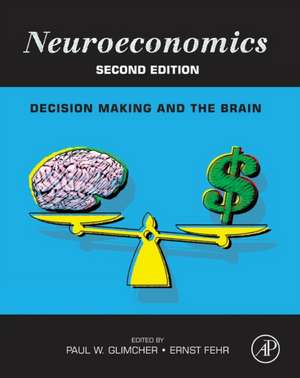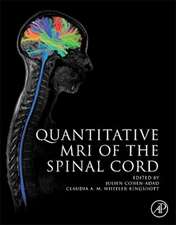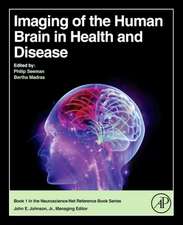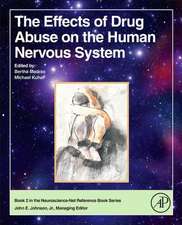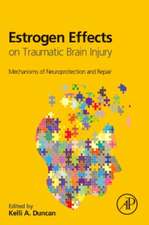Neuroeconomics: Decision Making and the Brain
Editat de Paul W. Glimcheren Limba Engleză Hardback – 3 oct 2013
- Editors and contributing authors are among the acknowledged experts and founders in the field, making this the authoritative reference for neuroeconomics
- Suitable as an advanced undergraduate or graduate textbook as well as a thorough reference for active researchers
- Introductory chapters on economics, psychology, neuroscience, and anthropology provide students and scholars from any discipline with the keys to understanding this interdisciplinary field
- Detailed chapters on subjects that include reinforcement learning, risk, inter-temporal choice, drift-diffusion models, game theory, and prospect theory make this an invaluable reference
- Published in association with the Society for Neuroeconomics—www.neuroeconomics.org
- Full-color presentation throughout with numerous carefully selected illustrations to highlight key concepts
Preț: 449.59 lei
Preț vechi: 562.21 lei
-20% Nou
Puncte Express: 674
Preț estimativ în valută:
86.04€ • 93.43$ • 72.27£
86.04€ • 93.43$ • 72.27£
Carte tipărită la comandă
Livrare economică 15-29 aprilie
Livrare express 15-21 martie pentru 110.66 lei
Preluare comenzi: 021 569.72.76
Specificații
ISBN-13: 9780124160088
ISBN-10: 0124160085
Pagini: 560
Ilustrații: illustrations
Dimensiuni: 216 x 276 x 33 mm
Greutate: 1.82 kg
Ediția:Revised
Editura: ELSEVIER SCIENCE
ISBN-10: 0124160085
Pagini: 560
Ilustrații: illustrations
Dimensiuni: 216 x 276 x 33 mm
Greutate: 1.82 kg
Ediția:Revised
Editura: ELSEVIER SCIENCE
Public țintă
Researchers and graduate students in neuroeconomics, behavioral / cognitive neuroscience, behavioral economics, and cognitive psychologyCuprins
Foreword
Introduction
Section 1: The Fundamental Tools of Neuroeconomics
1. Basic Methods from Neoclassical Economics
2. Experimental Economics and Experimental Game Theory
3. Computational Models of Decision-Making from Psychology and Behavioral Economics
4. Estimation and Testing of Computational Models
5. Computational Neuroscience
6. Experimental Methods in Cognitive Neuroscience
7. The Economics of Non-Human Primates
Section 2: Risk, Time, Social and Emotional Preferences
8. Computation of value in simple choices
9. Valuation for Risky and Uncertain Choices
10. Valuation, Intertemporal Choice and Self Control
11. Neuroeconomics of Social Preferences
12. The Study of Emotion in Decision Making
13. Valuation and Common Neural Currencies
14. The pharmacology of economic and social decision-making
Section 3: Learning and Valuation
15. Value Learning through Reinforcement: The Basics of Dopamine and RL
16. Advanced Issues in Reinforcement Learning
17. The Basal Ganglia, Reinforcement Learning and The Encoding of Value
18. From Experienced Utility to Decision Utility
Section 4: The Neural Mechanisms for Choice
19. Neural Mechanisms for Perceptual Decision-Making
20. Value-based Decision-Making
21. Multiple Systems for Valuation and Choice
22. Integrating Benefits and Costs in Decision-Making
23. Dynamic Neuronal Models of Choice
24. Reference Dependent Values and Normalization
Section 5: Brain Circuitry of Social Valuation and Social Choice
25. The Brain Circuity for Strategic Interactions
26. The Brain Circuity for social decision-making in non-human primates
27. Understanding Others: Brain Mechanisms of Theory of Mind and Empathy
Epilogue: Summary, Conclusions, and Prognostications
Appendix: Using Prospect Theory
Introduction
Section 1: The Fundamental Tools of Neuroeconomics
1. Basic Methods from Neoclassical Economics
2. Experimental Economics and Experimental Game Theory
3. Computational Models of Decision-Making from Psychology and Behavioral Economics
4. Estimation and Testing of Computational Models
5. Computational Neuroscience
6. Experimental Methods in Cognitive Neuroscience
7. The Economics of Non-Human Primates
Section 2: Risk, Time, Social and Emotional Preferences
8. Computation of value in simple choices
9. Valuation for Risky and Uncertain Choices
10. Valuation, Intertemporal Choice and Self Control
11. Neuroeconomics of Social Preferences
12. The Study of Emotion in Decision Making
13. Valuation and Common Neural Currencies
14. The pharmacology of economic and social decision-making
Section 3: Learning and Valuation
15. Value Learning through Reinforcement: The Basics of Dopamine and RL
16. Advanced Issues in Reinforcement Learning
17. The Basal Ganglia, Reinforcement Learning and The Encoding of Value
18. From Experienced Utility to Decision Utility
Section 4: The Neural Mechanisms for Choice
19. Neural Mechanisms for Perceptual Decision-Making
20. Value-based Decision-Making
21. Multiple Systems for Valuation and Choice
22. Integrating Benefits and Costs in Decision-Making
23. Dynamic Neuronal Models of Choice
24. Reference Dependent Values and Normalization
Section 5: Brain Circuitry of Social Valuation and Social Choice
25. The Brain Circuity for Strategic Interactions
26. The Brain Circuity for social decision-making in non-human primates
27. Understanding Others: Brain Mechanisms of Theory of Mind and Empathy
Epilogue: Summary, Conclusions, and Prognostications
Appendix: Using Prospect Theory
Recenzii
"This fully revised, second edition comes five years after the first and reflects the tremendous growth in the field of neurobiology of decision making…The text, uniformly well written and accessible, does not shy away from controversies in the research. This is an excellent text for either a graduate course or a very advanced undergraduate course on the subject." Summing Up: Recommended. --CHOICE Reviews Online, June 2014
"This book describes neuroeconomics, a combination of neuroscience and behavioral economics, with the goal of understanding how economic policies influence motivation on a neuropsychological level and, ultimately, behavior…This is an excellent book…It should be in the libraries of students and professionals interested in neuroeconomics."Rating: 4 Stars --Doody.com, April 4, 2014
Reviews for the First Edition:
"Neuroeconomics is a timely collection of papers by leading researchers from both sides of the border between economics and neuroscience…The book should be of interest to anyone who has ever wondered about the mechanics of how decisions are made in the brain, and what it means about human nature." --VINCE CRAWFORD, DISTINGUISHED PROFESSOR OF ECONOMICS, UNIVERSITY OF CALIFORNIA, SAN DIEGO, USA
"Economists pride themselves on rigorous parsimony. By taking the neural correlates of behavior into account, potentially explanatory variables explode. This book shows when digging deeper nonetheless pays for economics, and how to do it well." --CHRISTOPH ENGEL, EXECUTIVE DIRECTOR, MAX PLANCK INSTITUTE FOR RESEARCH ON COLLECTIVE GOODS, BONN, GERMANY
"For those onlookers who can’t quite accept that neuroscience may provide insight into how we decide what course of action to follow, the contributors to this comprehensive volume offer some very compelling, and very serious experimental and theoretical insights. Highly recommended, and enormously provocative." --FLOYD BLOOM, PROFESSOR EMERITUS, DEPARTMENT OF NEUROPHARMACOLOGY, THE SCRIPPS RESEARCH INSTITUTE, LA JOLLA, USA
"This book describes neuroeconomics, a combination of neuroscience and behavioral economics, with the goal of understanding how economic policies influence motivation on a neuropsychological level and, ultimately, behavior…This is an excellent book…It should be in the libraries of students and professionals interested in neuroeconomics."Rating: 4 Stars --Doody.com, April 4, 2014
Reviews for the First Edition:
"Neuroeconomics is a timely collection of papers by leading researchers from both sides of the border between economics and neuroscience…The book should be of interest to anyone who has ever wondered about the mechanics of how decisions are made in the brain, and what it means about human nature." --VINCE CRAWFORD, DISTINGUISHED PROFESSOR OF ECONOMICS, UNIVERSITY OF CALIFORNIA, SAN DIEGO, USA
"Economists pride themselves on rigorous parsimony. By taking the neural correlates of behavior into account, potentially explanatory variables explode. This book shows when digging deeper nonetheless pays for economics, and how to do it well." --CHRISTOPH ENGEL, EXECUTIVE DIRECTOR, MAX PLANCK INSTITUTE FOR RESEARCH ON COLLECTIVE GOODS, BONN, GERMANY
"For those onlookers who can’t quite accept that neuroscience may provide insight into how we decide what course of action to follow, the contributors to this comprehensive volume offer some very compelling, and very serious experimental and theoretical insights. Highly recommended, and enormously provocative." --FLOYD BLOOM, PROFESSOR EMERITUS, DEPARTMENT OF NEUROPHARMACOLOGY, THE SCRIPPS RESEARCH INSTITUTE, LA JOLLA, USA
